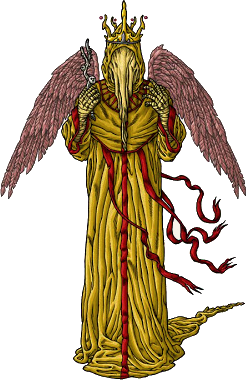Having read enough HP Lovecraft, I’m slowly, unsystematically making my way through his many influencers and contemporaries: writers like Edgar Allen Poe, Lord Dunsany, Arthur Machen, Algernon Blackwood, Clark Ashton Smith, William Hope Hodgson and many others mentioned in passing in ST Joshi’s Lovecraft biographies.1 One such minor influence is Robert W Chambers, particularly his 1895 collection of short stories, titled The King in Yellow.
Chambers, while a popular author in his day, did not prove to be a timeless one and has mostly fallen from public knowledge. However, a number of references to a “yellow king” and “Carcosa” in 2014’s True Detective series managed to yank this book onto the bestsellers list on Amazon for a bit.
Having recently watched True Detective, I was reminded of this book’s existence and thought it seemed interesting, so I decided to take a look. It’s old enough to be available for free on Project Gutenburg, so I didn’t even have to buy the Kindle edition.
I think I’ve made clear that my only interest in the Chambers stuff (Robert W. Chambers wrote “The King in Yellow”) is as a story that has a place in American myth.
[…]
For instance, if someone needs a book to read along with season 1 of “True Detective,” I would recommend the King James Old Testament. I wouldn’t tell anyone to go buy Robert Chambers. It’s not that great a book.
Nic Pizzolatto on The King in Yellow

The King in Yellow’s often-omitted subtitle is “and other horror stories”, and whether or not you note this will make a big difference in how you perceive the book. It contains ten stories: only five (maybe six) of them have anything to do with the titular King. If anything, the binding theme of the collection is “artists in Paris”. This is… less compelling than a mysterious devil king and a play that drives people who read it mad, so it’s no surprise the collection wasn’t named The Artist in Paris, but the Yellow King’s titular prominence may lead the reader to adopt a set of expectations that go largely unfulfilled.
The main expectation to discard is the idea that the stories are, as a whole, leading anywhere in particular. Despite some small crossovers of characters and settings between stories, each one is better taken on its own. The King in Yellow, Carcossa, and related concepts are hinted at and used for creepy flavour in much the same way as Pizzolatto did in True Detective. So if you were looking for explanation or enlightenment on that front, you’re not going to find it here, but if you were looking for more creepy hints about strange mythologies, then you’re in luck. There’s not a lot of it, but it’s there, and it’s effective.
I got the most enjoyment out of the first half of The King in Yellow, and would probably have a better opinion of it if the second half hadn’t soured me. If you’re going to read it, I recommend stopping after “The Demoiselle d’Ys”, unless you’re particularly fond of reading about artists in Paris (I wasn’t).
If you don’t have time even for that and just want to read one story from the collection, make it the first one, “The Repairer of Reputations”: one of its interesting features is that it takes place in the 1920s, but being written in 1895, this is an alternate future 1920s written without any inkling of the world-changing events of the early 20th century. As my addiction to pre-1980 serious sci-fi will attest, I really get a kick out of reading what people of the past thought the future would be like, and this is a very novel example, as both the present and predicted future relevant here are far enough in the past to be outside of living memory for 99% of the population.
So I guess this makes this book about 55% recommended then.
-
As I’ve said before, while I’m ambivalent about most of Lovecraft’s actual work, I’m quite interested in reading about his life. ↩︎
 David Yates.
David Yates.